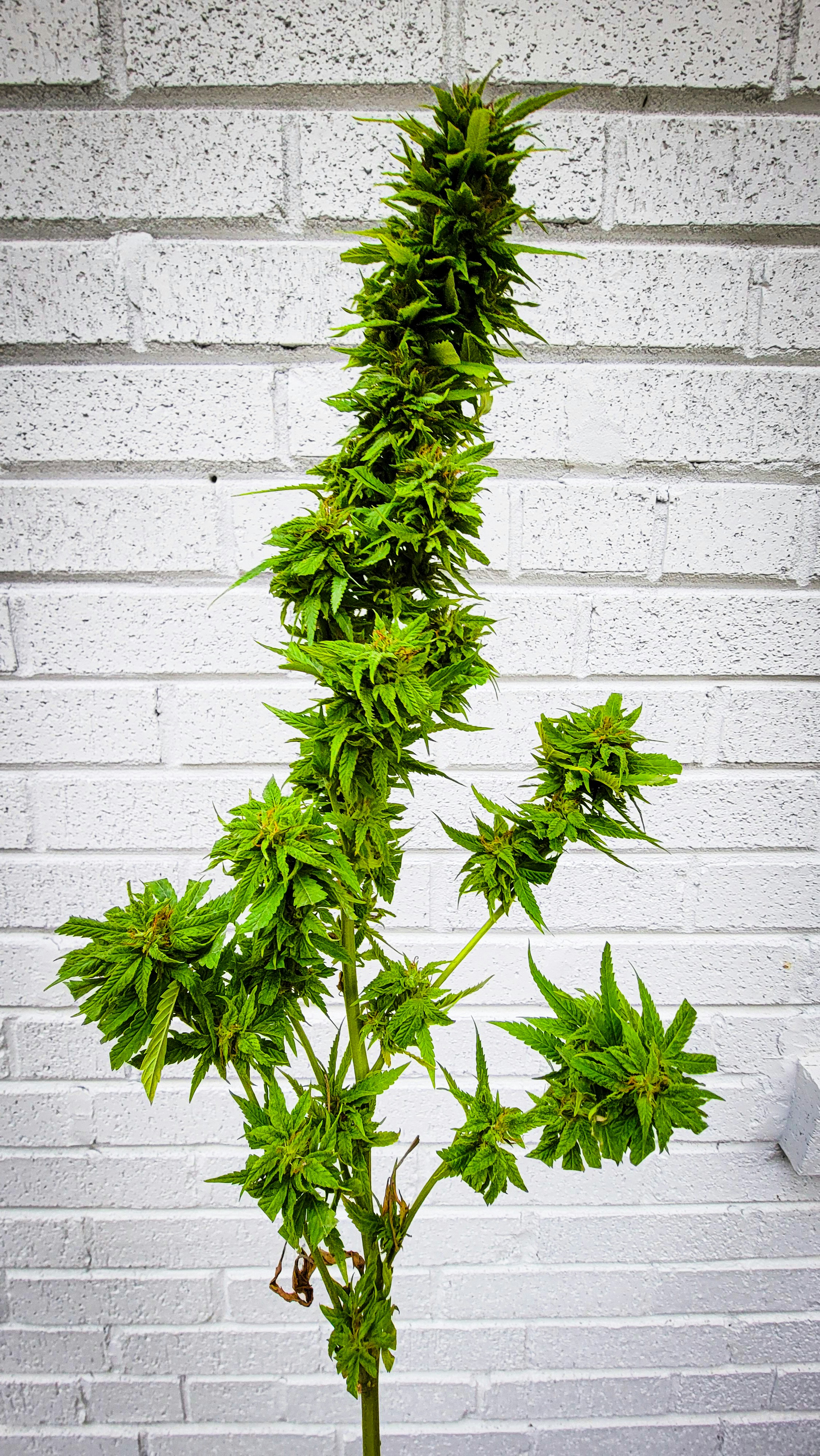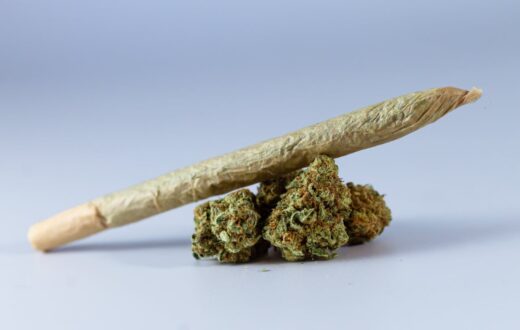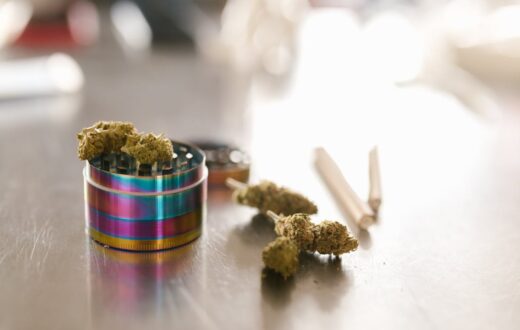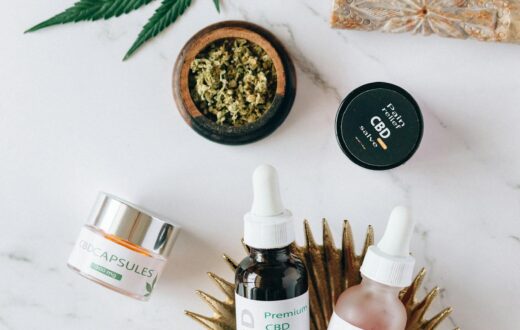Introduction to Blackberry Kush
Blackberry Kush is a renowned cannabis strain that has garnered much attention for its unique characteristics and appealing qualities. This indica-dominant hybrid boasts an intriguing heritage, stemming from the genetic lineage of Blackberry and an unspecified Kush strain. The combination produces a well-rounded experience that differs from many other cannabis varieties, making Blackberry Kush particularly sought after by both growers and consumers.
The strain’s striking aroma features rich notes of sweet berries, complemented by earthy undertones. This delightful fragrance is a key element that draws enthusiasts to Blackberry Kush, enhancing its visual appeal and overall experience. The flavor profile aligns closely with its aroma, delivering a smooth, fruity taste that can leave a lasting impression on connoisseurs. This combination of sensory attributes has contributed to the strain’s rising popularity in both recreational and medicinal cannabis markets.
When it comes to effects, Blackberry Kush is praised for its relaxing and calming properties. Many users report feelings of euphoria and sedation, making it an excellent choice for those seeking relief from stress, anxiety, or pain. Its high THC content contributes to a powerful experience that is cherished among cannabis aficionados. Additionally, the strain demonstrates a remarkable growth potential, often yielding substantial harvests, which makes it a favorite for home cultivators and professional growers alike.
Overall, Blackberry Kush stands out not just for its captivating flavor and effects but also for its ease of growth, making it an ideal choice for those interested in learning how to grow Blackberry Kush weed. With its rich lineage and unique qualities, it has established itself firmly in the cannabis community, satisfying the demands of both growers and users across varying preferences.
Understanding the Growth Requirements
To successfully cultivate Blackberry Kush weed, it is crucial to comprehend the specific growth requirements that influence its health and yield. This strain thrives in a controlled environment, particularly when focusing on optimal temperature, humidity levels, and light exposure. Understanding these factors may significantly enhance the overall growth of the plant.
The ideal temperature for growing Blackberry Kush cannabis usually ranges between 70°F to 80°F (21°C to 27°C) during the day and slightly cooler at night. Such temperature regulation is paramount, as excessive heat can harm the plant, leading to issues such as nutrient uptake deficiency and stunted growth. When cultivating Blackberry Kush weed indoors, growers should utilize thermostats and fans to maintain these temperature levels reliably.
Humidity also plays a critical role in the growth of Blackberry Kush. During the vegetative stage, a humidity level between 40% and 70% is recommended to promote healthy leaf development. As flowering begins, growers should gradually lower humidity to around 40% to 50% to prevent mold and mildew, which poses a risk to dense flower clusters formed during this stage. Monitoring humidity can be managed through dehumidifiers or by adjusting water intake for the plants.
Light exposure is equally important for Blackberry Kush weed. This strain flourishes under a light cycle of 18 hours of light and 6 hours of darkness during its vegetative phase, while switching to a 12/12 light cycle is crucial for triggering flowering. Utilizing high-quality grow lights can ensure that plants receive sufficient light intensity, contributing to robust development and enhanced cannabinoid production.
In conclusion, the growth requirements for Blackberry Kush weed play a vital role in achieving a healthy, fruitful yield. By maintaining optimal temperature, humidity, and light conditions, cultivators can create an environment conducive to the thriving growth of this popular strain.
Choosing the Right Growing Medium
Choosing the appropriate growing medium is crucial for the successful cultivation of Blackberry Kush weed. The choice primarily comes down to soil, hydroponics, and coco coir, each offering distinct benefits and drawbacks. Understanding the characteristics of these mediums will enable growers to make informed decisions that align with their cultivation goals.
Soil is the most traditional growing medium, known for its stability and ability to provide essential nutrients through organic matter. For Blackberry Kush, a nutrient-rich soil mix infused with compost can promote healthy root development and robust plant growth. However, soil can sometimes retain too much moisture, which may lead to root rot if overwatered. Growers will need to monitor water levels carefully, especially during the flowering stage when the plants are particularly susceptible to stress.
Hydroponics, on the other hand, offers a soilless growing approach where plants are nourished through nutrient-rich water solutions. This method can lead to faster growth rates and higher yields for Blackberry Kush due to the optimal nutrient absorption. However, hydroponic systems can be complex and require a more conscientious effort to maintain proper pH levels and nutrient concentrations. This growing medium may not be suited for beginners who are still mastering the fundamentals of cannabis cultivation.
Coco coir is another viable option that combines qualities from both soil and hydroponics. This medium is made from coconut husks and provides excellent aeration and drainage, making it easier to prevent overwatering. It also retains moisture well, providing an efficient means of encouraging Blackberry Kush’s root health. Nevertheless, coco coir is often devoid of essential nutrients, requiring growers to supplement with a nutrient solution. Growers should weigh these pros and cons and consider their experience level and available resources when selecting the best medium for cultivating Blackberry Kush weed.
Cloning vs. Seed Germination: Which Is Better?
When considering how to grow Blackberry Kush weed, one of the initial decisions to make involves the method of propagation: cloning or seed germination. Each approach has its unique advantages and drawbacks, which can significantly influence the success of the cultivation process.
Cloning involves taking cuttings from a mature Blackberry Kush plant and encouraging them to root, thus producing genetically identical plants. This technique is particularly advantageous for experienced growers seeking to replicate specific traits of a successful mother plant, such as potency or yield. A notable benefit of cloning is that it often results in faster growth compared to seed germination, as clones maintain the vegetative maturity of the parent plant. However, cloning requires a healthy mother plant and can lead to the propagation of diseases if the original plant is not disease-free.
On the other hand, seed germination is the traditional method of starting cannabis plants. Seeds offer the benefit of genetic diversity, allowing growers to experiment with different phenotypes of Blackberry Kush. Additionally, germinating seeds can lead to robust plants, as they are not reliant on another plant’s health. The process also comes with its own set of challenges; germination can be unpredictable, and seedlings require careful monitoring to ensure proper growth and development. Moreover, seeds can take longer to grow into mature plants compared to clones. This method may require a bit more time and patience, but for many, the excitement of nurturing a plant from seed to harvest is well worth the effort.
Ultimately, the choice between cloning and seed germination depends on individual preferences, resources, and experience levels. Those with a solid understanding of how to grow Blackberry Kush weed may benefit from cloning, while novices might find seed germination to be more manageable and rewarding.
Nutrient Management for Optimal Growth
When cultivating Blackberry Kush weed, understanding nutrient management at different growth stages is paramount for ensuring optimal health and yielding a bountiful harvest. This strain, like many others, has specific nutritional needs during its seedling, vegetative, and flowering phases, which must be closely monitored and adjusted accordingly.
During the seedling stage, Blackberry Kush requires a nutrient mix rich in nitrogen, phosphorus, and potassium, albeit in lower concentrations to prevent nutrient burn. A balanced N-P-K ratio of approximately 2-1-2 is often beneficial. The soil pH should be maintained between 5.5 and 6.5, optimizing nutrient uptake. It is advisable to water the seedlings lightly and with frequency, ensuring that the young plants do not dry out, which can stunt their early growth.
As the plants transition into the vegetative phase, the nitrogen requirement increases significantly to promote robust leaf and stem development. A higher N-P-K ratio of 3-1-2 can be introduced at this stage, alongside supplementary micronutrients such as magnesium and calcium. Proper feed schedules typically involve fertilizing every two weeks, ensuring that plants receive adequate nutrition without overwhelming them. The soil pH should continue to be monitored to remain within the range of 6.0 to 7.0.
When Blackberry Kush enters the flowering phase, the nutrient focus shifts from nitrogen to phosphorus and potassium, essential for bud development. A recommended N-P-K ratio is 1-3-4 during this phase. Additionally, reducing nitrogen will help prevent excess foliage growth, allowing the plant to dedicate resources towards producing high-quality flowers. The optimal pH during this stage should be about 6.0 to 6.5. Implementing a careful feeding schedule in conjunction with regular pH testing will significantly influence the overall yield and quality of the Blackberry Kush crop.
Pest and Disease Management
Successful cultivation of Blackberry Kush weed requires a keen understanding of the potential threats posed by pests and diseases. These factors can significantly hinder the growth process and affect yield quality. Notable pests that can target Blackberry Kush plants include aphids, spider mites, and whiteflies. Additionally, diseases such as powdery mildew and root rot can also emerge if plants are not given the proper care.
To effectively manage these pests and diseases, prevention is paramount. Growers should consider implementing an integrated pest management (IPM) strategy. This approach includes regular monitoring of crops for early signs of infestation. Employing companion planting can also be beneficial, as some plants naturally repel harmful pests. Incorporating beneficial insects, like ladybugs and predatory mites, can aid in controlling pests naturally without the need for harsh chemicals.
In addition to preventive measures, immediate action is crucial once any pest or disease is detected. Organic solutions such as neem oil or insecticidal soap can effectively manage pest populations on Blackberry Kush weed without introducing harmful chemicals into the ecosystem. For diseases, maintaining optimal humidity levels and ensuring proper airflow around the plants can help prevent issues like powdery mildew. In cases where organic solutions are ineffective, growers may need to resort to chemical alternatives. In such situations, it is essential to select products that are specifically designed for the cannabis industry and follow all application guidelines strictly.
Monitoring environmental conditions, along with thorough cleaning of the growing area, will reduce the chance of pests and diseases recurring. By understanding how to grow Blackberry Kush weed effectively, including implementing comprehensive pest and disease management strategies, cultivators can safeguard their plants and promote a healthy growth environment, ultimately leading to an abundant yield.
Pruning and Training Techniques
Effectively managing the growth of Blackberry Kush weed through pruning and training techniques is an essential practice for optimizing yields. A well-pruned plant not only enhances light penetration but also improves airflow, which is crucial for preventing mold and promoting overall plant health. Understanding key methods such as topping, low-stress training (LST), and the Screen of Green (ScrOG) technique can provide significant advantages for growers.
Topping is one of the most straightforward methods of pruning. By cutting off the top of the main stem, growers encourage the development of lateral branches, resulting in a bushier plant. This technique allows for more colas to receive sunlight, ultimately increasing the potential yield of Blackberry Kush weed. Typically, topping is done once the plant has developed at least five nodes, ensuring that it can recover and thrive post-pruning.
Low-stress training (LST) involves gently bending and tying down the branches of the Blackberry Kush plants to encourage horizontal growth. This practice allows light to reach more parts of the plant, which stimulates growth and can lead to a more even canopy. Utilizing soft ties or plant clips will prevent damage while securing the branches in their desired positions. By applying LST, growers not only enhance light exposure but also make the most of limited space.
The ScrOG technique utilizes a screen placed above the plants, allowing the grower to weave the branches through the openings. This method encourages an even distribution of light and maximizes the growth potential of Blackberry Kush weed. Ensuring that all buds are at a similar height can lead to a more uniform harvest, making ScrOG an advantageous option for both novice and experienced cultivators.
In conclusion, implementing effective pruning and training techniques for Blackberry Kush weed can significantly impact growth and yield. By employing methods such as topping, low-stress training, and ScrOG, growers can optimize their plants for maximum productivity and health.
Harvesting and Curing Your Blackberry Kush
Harvesting Blackberry Kush weed is a critical step in the cultivation process, requiring careful attention to detail. The ideal time for harvesting occurs when the trichomes, which are tiny resin glands on the buds, turn from clear to a milky white. A few amber-colored trichomes will also be present, indicating peak potency. Observing these signs ensures that the BlackBerry Kush plants have reached their full potential in terms of flavor and effects.
To prepare for harvesting, it is advisable to take the time to assess the growth conditions and ensure that the plants are healthy. If the conditions of light and hydration have been meticulously maintained, the outcome will be optimal. Begin the harvesting process by using sharp, sterilized scissors or pruning shears to cut down the branches. It is best to work in a cool, dry place to avoid mold and degradation of the buds during the cutting process.
Once harvested, the next crucial step is the curing process, which significantly enhances the flavor, potency, and overall shelf-life of Blackberry Kush. Start by trimming off excess leaves surrounding the buds, as these can impact the taste and quality of the final product. Following that, hang the trimmed buds upside down in a dark, well-ventilated space. Maintaining a temperature between 60-70°F (15-21°C) with humidity levels around 50-60% is ideal during this phase.
Leave the buds to dry for about 7 to 14 days, checking regularly for signs of dryness. When the buds feel dry to touch and the stems snap instead of bending, it is time to proceed to the curing phase. Place the dried buds in airtight glass jars, filling them about three-quarters of the way full to allow for airflow. Open the jars daily for the first couple of weeks to facilitate gas exchange, a process known as “burping”. Over time, this will result in a well-cured Blackberry Kush that boasts a rich flavor profile and enhanced potency, ready for consumption.
Conclusion and Final Thoughts
Growing Blackberry Kush weed successfully involves a multifaceted approach that encompasses understanding the plant’s requirements, providing optimal growing conditions, and employing proper care techniques. Throughout this article, we have explored various essential practices that can significantly influence the growth of this particular strain, known for its rich flavors and relaxing effects.
To start, it is crucial to select high-quality seeds or clones, as the genetic foundation will ultimately determine the plant’s health and yield. Subsequently, understanding the importance of environment — whether growing indoors or outdoors — lays the groundwork for providing the right conditions, such as humidity, light, and temperature levels. This knowledge helps maximize growth and ensures the Blackberry Kush can thrive.
Furthermore, we discussed the significance of nutrients and feeding schedules, highlighting how the right balance can enhance the plant’s growth during various stages of its lifecycle. Regular monitoring and maintenance practices such as pruning and pest management are equally essential, as they contribute to a more robust and productive cannabis plant.
As you embark on your journey of learning how to grow Blackberry Kush weed, remember that experience plays a vital role. Each grower’s environment and methods may vary, leading to unique results. Therefore, it is recommended to document your cultivation practices, allowing you to refine your techniques over time. Engaging with fellow cannabis enthusiasts through forums and social media can also lead to valuable insights and shared experiences that can enrich your growing knowledge.
Ultimately, the process of growing Blackberry Kush can be rewarding both in terms of the product yield and the personal satisfaction that comes with successful cultivation. By applying the techniques discussed, you can join a community of passionate growers and contribute to the collective knowledge of this enjoyable hobby.














